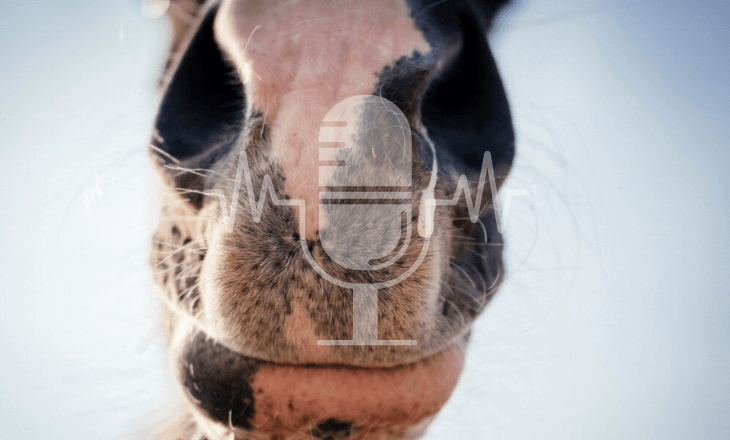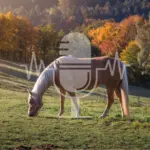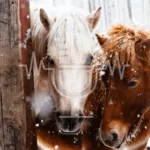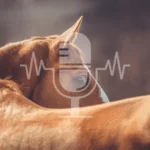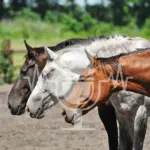— when Father Christmas stops by the stables as well…
The smart new cooler rug with the subtly contrasting trim? Or the flashy show halter with Swarovski crystals? Oh no— even better, those gorgeous leather reins that feel so good in the hand. And a bag of treats for the little rascal, of course.
When we horse owners go shopping for our favourites, it all gets cheerfully muddled between what soothes our soul and what the horse actually needs. The ever-growing tack locker — not to mention the stuffed car boot and the overflowing cupboard in the cellar — tells the story loud and clear. And in the end, we still reach for the same old headcollar while the other thirty gather dust in the cupboard…
So, what would our horse put on its wish list to the Christmas stallion — pardon, Father Christmas?
An all-weather, surfaced paddock — ideally with a bit more space
Lack of space is the number one problem in most yards over winter. It’s lovely if the horses get fresh air, but if the paddock is no bigger than the stable, that’s hardly right for an animal built to move. And unfenced, unsurfaced runs where, in wet weather, horses are up to their ears in mud are not a species-appropriate solution either. Generous turnout areas — ideally a paddock-track system with a long stretch you can canter down — would be perfect.
Dear Father Christmas, could you bring a little bit of the Mongolian steppe to our yard — you know, for more space and dry hooves?
Plenty of good-quality horse hay
In many yards, forage is still fed as if it were gold dust. But horses are trickle feeders: in the wild they nibble around the clock on grasses, leaves, bark and twigs. Feeding in set meals is a human habit that leaves horses hungry and irritable and can also cause metabolic problems. A constant supply of good-quality horse hay — offered via haynets if needed — should be standard in every yard.

Dear Father Christmas, never mind the Christmas turkey — I’d much rather be able to munch hay to my heart’s content, all day and all night. And could the haynet holes not be too tiny…?
Time off from training
Not only we humans appreciate a holiday from the daily grind, when we can simply let body and soul unwind. Horses benefit too if they get 2–3 months off from training and competition stress over winter. And honestly: if a horse hasn’t grasped its job in the other 9–10 months of the year, no amount of hard-nosed winter schooling will turn it into a star performer. Better to wind the workload down calmly for 3–4 weeks after the last show in autumn, then switch to easy hacks or the odd relaxed gymnastic session with no pressure to achieve. You will head into the new season with a far more motivated horse.
So, you know, dear Father Christmas: send good weather so the hacking is more tempting than the dreary indoor school!
A best mate
Horses are social animals; they need physical and mental contact with their own kind just as we do. Unfortunately, our management often means keeping them either on their own with only visual contact — in a stable or in a paddock-box set-up — or bundling them into enforced groups where they have to rub along with horses they’d otherwise prefer to avoid.
Watch horses on large pastures and you will often see big herds break up into smaller units. A herd is usually made up of several pairs. So, every horse needs a best mate — to claim the nicest grazing spot together, swish flies off each other, and scratch the places they can’t reach on their own.

© cornfield / Adobe Stock
Honestly, dear Father Christmas, what’s a warmblood like me meant to do with a companion Shetland—other than act as his sunshade? I’d much prefer a mate that matches me in size and temperament, thank you.
Stability in life
Horses are creatures of habit. It sounds obvious, but we forget it all too easily in day-to-day yard life. Every change means stress for a horse — whether that’s a trip to a show or a fortnight’s holiday, new horses being added to the group or the lead mare leaving. Even something as simple as the rider turning up to ride at an unusual time can tip some horses into stress. As prey animals, most horses’ welcome routine and predictability because they signal safety; any deviation is, potentially, life-threatening. So, it’s worth thinking carefully before you pull a horse out of its familiar routine.
Dear Father Christmas, please take the ants out of my owner’s pants and show them they can simply “be” with me — they don’t always have to “do.”
- Podcast #8 – When the Cold Wave Hits Your Barn: How to Help Horses with Colds and Respiratory Infections - 9. October 2025
- Podcast #7 – Pasture Management for Laminitis-Prone Horses: What Every Horse Owner Needs to Know - 9. October 2025
- Podcast #6 – Clipping, Blanketing, or Fluffy Coat? How to Keep Your Horse Comfortable in Winter - 9. October 2025






